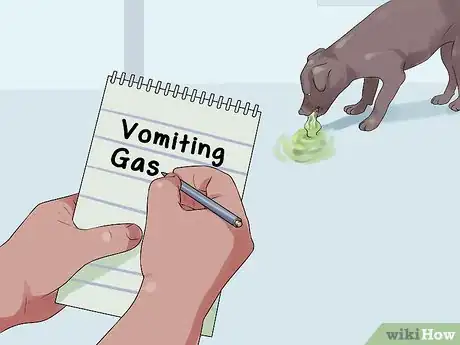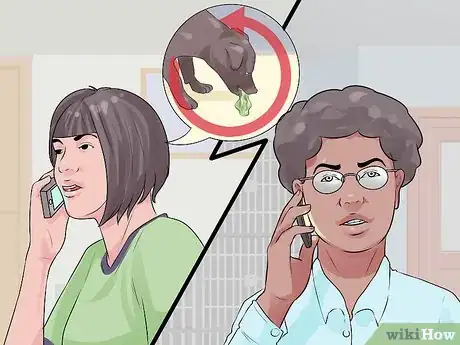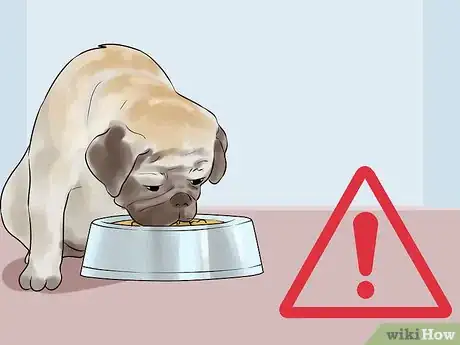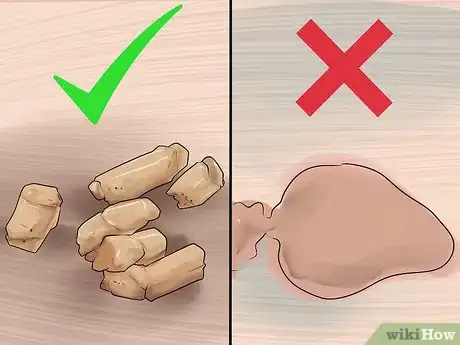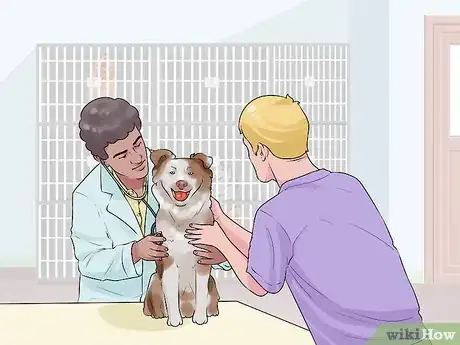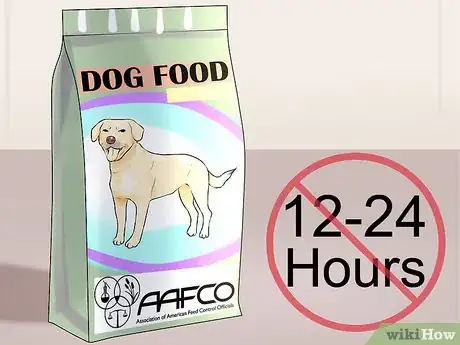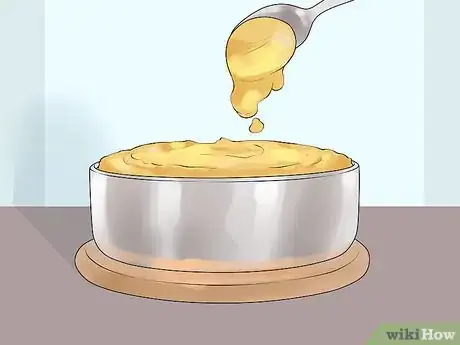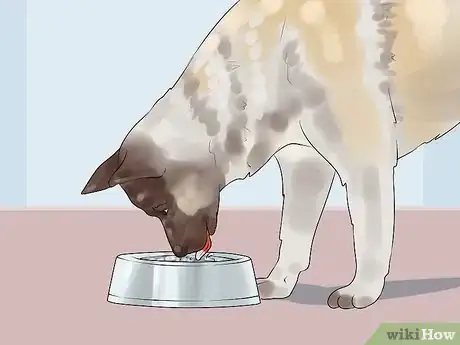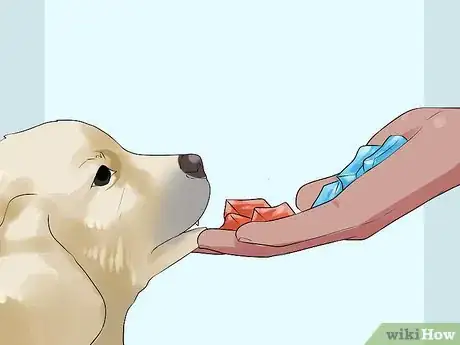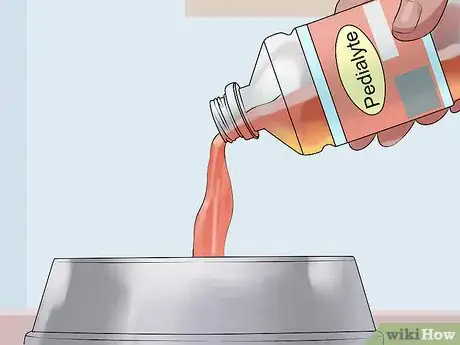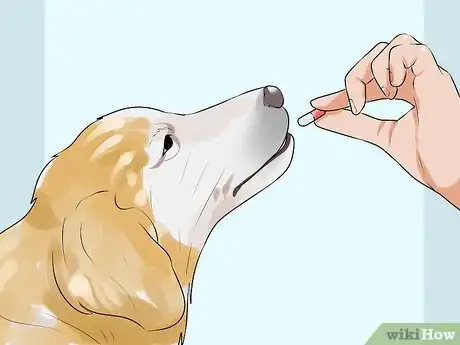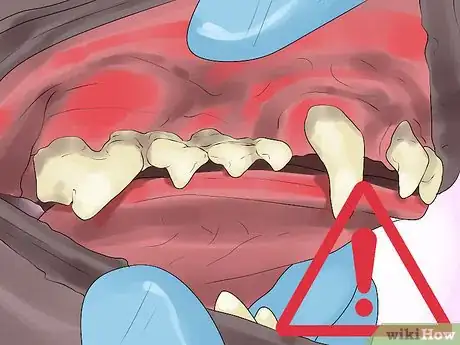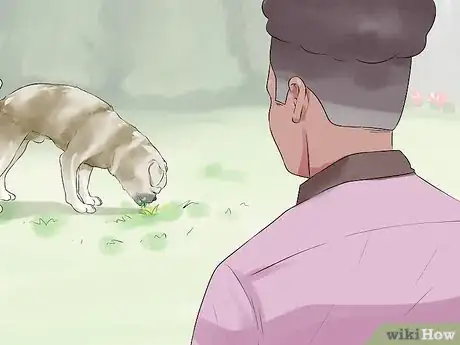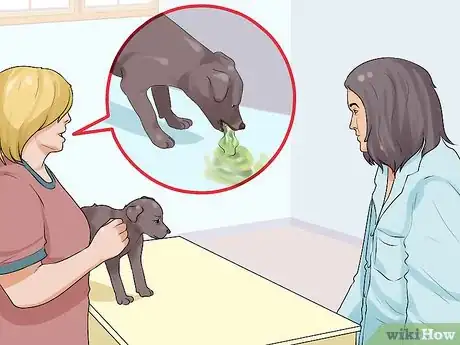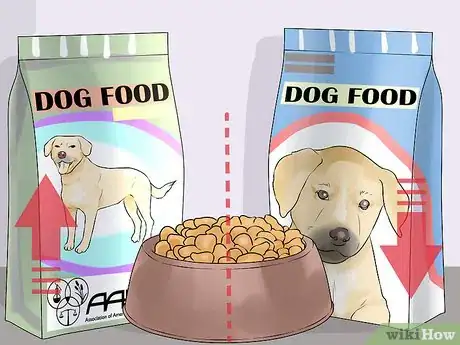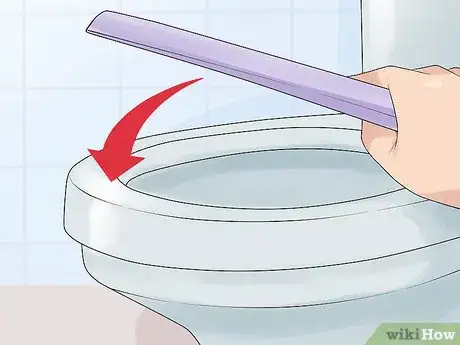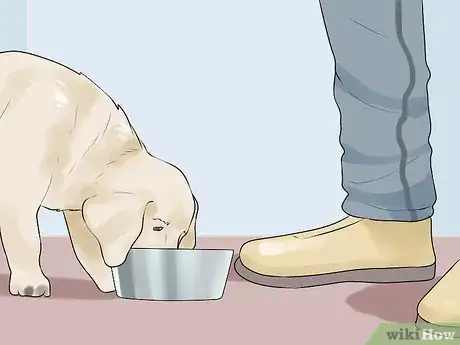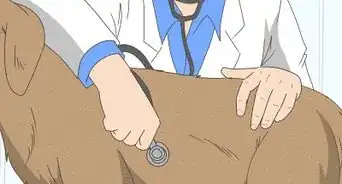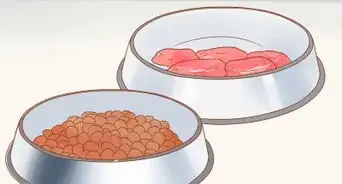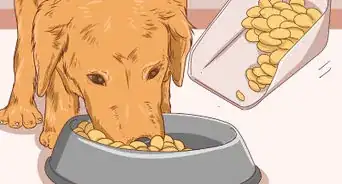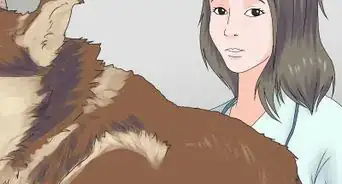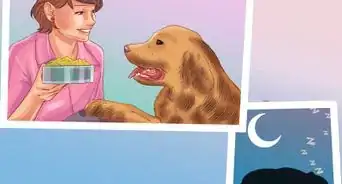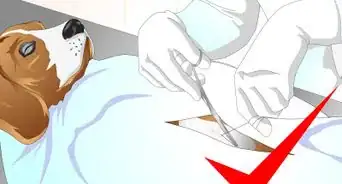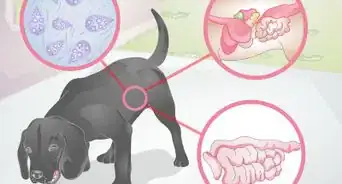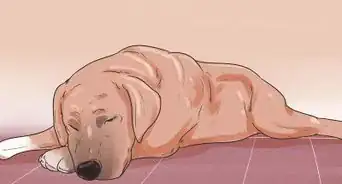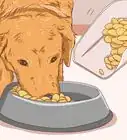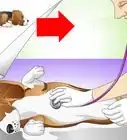This article was co-authored by Pippa Elliott, MRCVS. Dr. Elliott, BVMS, MRCVS is a veterinarian with over 30 years of experience in veterinary surgery and companion animal practice. She graduated from the University of Glasgow in 1987 with a degree in veterinary medicine and surgery. She has worked at the same animal clinic in her hometown for over 20 years.
There are 18 references cited in this article, which can be found at the bottom of the page.
This article has been viewed 16,267 times.
If you just adopted a new dog, you may be worried or surprised if they have digestive issues, such as gas, vomiting, a grumbling stomach, or diarrhea. Some issues are fairly common (such as diarrhea due to a change of diet); however, some issues, such as vomiting, are more serious and should be addressed quickly. For serious digestive problems, contact the adoption agency, as well as your vet for evaluation.
Steps
Identifying the Problem
-
1Record the symptoms. Write down all of the dog’s symptoms as they occur. Not only should you record what symptoms the dog is having but also note when they are occurring and what you think might be causing them. For example, if the dog vomits after eating food, there may be a problem with what you are feeding them. Some symptoms you should look out for include:[1]
- Vomiting
- Gas
- Diarrhea
- Constipation
- Regurgitation
- Blood or mucus in their feces
- Weakness or lethargy
-
2Track how long they have had the issue. If the dog has only been home with you for a few days, call the shelter, and ask them if the dog has had the same problems in the past. Explain the dog’s symptoms to them. They may be able to check the dog’s record to see if the problems are chronic or not. You can ask:
- ”Do you know if the dog has had vaccinations in the past? If so, which vaccinations did they receive?”
- “Are there any issues with parasites at your kennel?”
- “Have you noticed these symptoms in the past with this dog? How about with other dogs in the shelter?”
- “Is this a common problem when dogs return home?”
- “What did you feed the dog while they were in your shelter? Can you tell me the brand and type of food? Is there somewhere nearby I can find this food?”
Advertisement -
3Consider what the dog has eaten. One common digestive issue that affects recently adopted dogs is a sudden change in diet. When a dog switches to a new type or brand of food, their stomachs may need a few days to adjust. Furthermore, dogs in a new home may be curious, and they may eat things that they shouldn’t.
- Changing a dog’s diet too suddenly can cause them to have an upset stomach with diarrhea or gas. Normally, you should transition their diet by mixing their old shelter food with their new food. If you did not do this, revert to the dog's old diet. Feed them whatever food they were fed in the shelter, and watch to see if symptoms disappear.[2]
- Dogs who are fed “people food” or table scraps may have problems with the high fat content found in these foods. Furthermore, some foods that are safe for humans to eat, such as chocolate or garlic, are not safe for dogs to consume.[3]
-
4Inspect their feces. When the dog eliminates, take a careful look at their feces. Normal dog stool should be brown and shaped like a log (although if the dog is on a raw food diet, the feces may be white and crumbly). You should be able to pick it up without it crumbling, falling apart, or running through your fingers.[4] If the dog’s stool is liquid, runny, or loose, they may have diarrhea or a related problem. If their stool is small, crumbly, and dry, they may have constipation.
- If the dog has blood or discolored mucus in their feces, take them to a vet immediately.
- If the dog’s feces are yellow, green, black, or orange, tell your vet.
-
5Take the dog to the vet. If the dog’s symptoms last longer than 24 hours, take the dog to the vet to be tested. Or, if the dog is vomiting for more than four hours or can't keep fluids down, then take them to the vet right away. There are a number of problems that could cause digestive issues in a dog, including parasites, bacterial or viral infection, inflammation, or allergies. The vet can do a number of tests, including fecal tests, blood tests, electrolyte tests, x-rays, and endoscopies.[5] Be sure to tell the vet:
- Any symptoms you have recorded
- How long the symptoms have lasted
- When the symptoms typically appear
- What the dog has been eating recently
- If the dog has swallowed an inedible or poisonous object
Fasting and Feeding Your Dog
-
1Avoid giving your dog food for a day. When your dog first starts experiencing diarrhea, stop feeding them for between twelve and twenty-four hours. This will prevent further episodes. If they keep having diarrhea after you have taken the food away, or they are vomiting, contact your vet.
- If you have a puppy, only fast them for twelve hours. You can place a little bit of pancake syrup on their gums to make sure that they are getting a little bit of energy.[6]
-
2Feed them plain food. If they can keep their food down or if you have already fasted the dog, you should try giving them plain, cooked foods. These foods should not be spiced, greasy, or processed. Some foods you can give your dog include:
-
3Provide plenty of fresh water. Digestive issues can often dehydrate a dog, especially if they are vomiting or having diarrhea. Make sure your dog is drinking plenty of fresh water. Change the water at least twice a day. If your dog is not drinking, try leading them to the bowl or placing the bowl near them to encourage them to drink.[9]
- Give the dog small amounts of water. Too much water at one time can cause them to vomit.[10]
- Add a little bit of water to whatever food you give them. This can help hydrate them as they eat.
-
4Offer the dog ice chips. If the dog is drinking too much water at once, they may start vomiting. This will only increase their dehydration. If you suspect this is the case with your dog, give them ice chips instead. The dog will suck on the ice chip slowly.
- Try freezing Gatorade ice cubes to help restore the electrolytes your dog has lost by vomiting.
- If the dog has not vomited for four hours, you can reintroduce small amounts of water. Start by giving half a cup of water, and monitor them to see if they can keep it down.[11]
-
5Give the dog Pedialyte. If the dog is having trouble keeping food down or if they are dehydrated, you can give them Pedialyte to restore electrolytes and vitamins to their system. You can use unflavored Pedialyte bought at the drugstore or animal-friendly powder mix bought found at a farming store.[12]
- If you bought powder, you can mix it with water according to the instructions on the packet.
- If the dog is able to keep water down, you can add Pedialyte, Gatorade, or meat broth (with no onion or garlic) to their water bowl. Dilute the liquid with an equal amount of water.[13]
-
6Feed the dog with a syringe. If the dog is not eating or drinking at all, you may have to feed them Pedialyte with a syringe. Fill the needleless syringe with Pedialyte, and place it between their gums and cheek on one side of their mouth. Gently press out the liquid into their mouth. It is highly advised that you get your vet to show you the proper method to do this, as sick dogs are likelier to choke or aspirate on the food.[14]
-
7Treat poisonous substances with cooking oil. If you think that the dog has consumed a petroleum based product — such as gasoline, motor oil, or lighter fluid — or if they have swallowed a cleaning product — like antibacterial spray or laundry detergent — give them a tablespoon or two of cooking oil. Contact an emergency vet immediately. Do not induce vomiting.[15]
Monitoring Your Dog
-
1Give the dog their medications. If the vet prescribed you a medication, you should have it filled at their animal hospital or at a local pharmacy. Follow the vet’s instructions for administering the medication to the dog.[16]
- If the vet gave you a pill, ask if the pill can be given with food. If it can be, put a little peanut butter or cream cheese on the pill to encourage the dog to swallow it.
- If the pill can't be given with food, place your hand on the top of the dog’s muzzle and gently squeeze near the canines until the dog opens their mouth. Place the pill on the back of their tongue, and close their mouth.[17]
-
2Check for dehydration. Dehydration is a serious side effect of digestive problems. If untreated, it can lead to organ failure. If your dog is not drinking or if they continue vomiting for over twenty-four hours, you may need to have a vet give them fluids using an IV. You can tell if a dog is dehydrated using a few simple methods. If the dog fails any of these tests, return to the vet.
- Check the dog’s gums to see if they are wet. If the gums appear dry, they may be dehydrated.
- Press down on the gums with your finger until you notice a change in color. If the dog is hydrated, the original color will return as soon as you remove your finger. If it takes a few seconds to regain color, the dog may be dehydrated. Be careful with this method if the dog is still unfamiliar with you as they may bite.
- Gently grasp the scruff of their neck, and tug it upwards. If the skin retracts immediately, they are fine. If the skin sticks and or does not snap into place, the dog may be dehydrated.[18]
-
3Take the dog outside. Make sure that the dog has plenty of opportunities to go outside, especially if they are vomiting or having diarrhea. Not only will this allow them to eliminate safely, they may also start to eat grass. While the reasons that dogs eat grass are largely unclear, many nauseous dogs will eat grass to settle their stomachs or to induce vomiting. This may be a natural way to help your dog feel better.[19]
- Do not worry if the dog vomits after eating grass. This is normal. Some dogs may even eat grass to help them empty their stomachs.
-
4Return to the vet if necessary. If the dog is dehydrated or if vomiting and diarrhea continue, contact the vet. The vet may decide to run more tests. They may also try to deliver fluids and food via IV or syringe.
Preventing Future Upsets
-
1Transition the dog to new dog food slowly. If you are feeding the dog a different brand or type of food than they were eating at the shelter, you should try to slowly transition them to the new food. Find out what the shelter was feeding them. Mix a little bit of new food in with the old food. Over ten days, gradually increase the amount of new food that you give them while decreasing the amount of old food. In general, you can follow this schedule to transition the food:[20]
- Day one to three: mix 75% old food mixed in with 25% new food
- Day four to six: mix 50% old food mixed in with 50% new food
- Day seven to nine: mix 25% old food mixed in with 75% new food
- Day ten: feed them only the new food
-
2Dog proof your home. To make sure that your new dog does not get ahold of anything that could upset their stomach, you should make sure that all potentially dangerous substances, plants, and objects are out of the way. To dog-proof your home, you can:[21]
- Put cleaning supplies, medicines, chemicals, and lotions on higher shelves or locked cabinets.
- Cover trashcans or place them inside a cabinet or closet.
- Place the toilet lid down.
- Make sure food is out of reach.
- Clean up antifreeze, motor oil, and gasoline from the garage floor or driveway.
- Pick up small objects, such as buttons, spools of thread, or plastic toys, from the ground.
-
3Monitor what they eat closely. Make sure that the dog is only eating food that is safe for them. Limit how much “people food” you give them, and make sure you never give them food that contains chocolate, garlic, or onions. Keep the dog away from trash.[22]
- If the vet has diagnosed an allergy, make sure never to feed the dog food that contains the offensive ingredient. You should read the ingredients of all treats and dog food that you purchase in the future.
Warnings
- Chocolate, onions, and garlic can be poisonous to dogs.⧼thumbs_response⧽
- Gastroenteritis is an inflammation of your dog’s digestive tract. It can be caused by metabolic disorders, parasites, allergies, irritable bowel syndrome, the ingestion of feces or table scraps, or by obstruction of the gut (typically caused by swallowing a foreign object like a sock). It is important to take your dog to the vet so that the cause of their distress can be appropriately diagnosed and treated.[23]⧼thumbs_response⧽
- Dehydration is an extremely serious side effect of vomiting and diarrhea. Do not delay in trying to rehydrate your dog. If you are worried that your dog is not getting enough fluids, ask your vet to help you.⧼thumbs_response⧽
References
- ↑ http://www.hillspet.com/en/us/dog-care/healthcare/dog-gastrointestinal-and-digestive-problems
- ↑ https://www.caninejournal.com/changing-dog-food/
- ↑ http://www.akc.org/content/health/articles/human-foods-dogs-can-and-cant-eat/
- ↑ https://pethelpful.com/dogs/Dog-Stool-Information-What-do-Normal-Dog-Stool-Look-Like
- ↑ http://www.pethealthnetwork.com/dog-health/dog-diseases-conditions-a-z/gastroenteritis-dogs
- ↑ https://pethelpful.com/dogs/Dog-upset-stomach-home-remedy
- ↑ https://www.caninejournal.com/cure-dogs-upset-stomach/
- ↑ https://www.petcarerx.com/article/what-to-feed-a-sick-dog-so-theyll-feel-better/1380
- ↑ https://www.caninejournal.com/cure-dogs-upset-stomach/
- ↑ https://pethelpful.com/dogs/Dog-upset-stomach-home-remedy
- ↑ https://pethelpful.com/dogs/Dog-upset-stomach-home-remedy
- ↑ https://www.caninejournal.com/cure-dogs-upset-stomach/
- ↑ https://pethelpful.com/dogs/Dog-upset-stomach-home-remedy
- ↑ https://www.petcarerx.com/article/what-to-feed-a-sick-dog-so-theyll-feel-better/1380
- ↑ http://www.canismajor.com/dog/intestin.html
- ↑ http://www.pethealthnetwork.com/dog-health/dog-diseases-conditions-a-z/gastroenteritis-dogs
- ↑ http://www.peteducation.com/article.cfm?c=2+2099&aid=1072
- ↑ https://www.petcarerx.com/article/what-to-feed-a-sick-dog-so-theyll-feel-better/1380
- ↑ http://moderndogmagazine.com/articles/vet-s-take-why-dogs-eat-grass/297
- ↑ http://www.drsfostersmith.com/pic/article.cfm?aid=99
- ↑ https://www.americanhumane.org/fact-sheet/pet-proofing-your-home/
- ↑ http://www.pethealthnetwork.com/dog-health/dog-diseases-conditions-a-z/gastroenteritis-dogs
- ↑ http://www.pethealthnetwork.com/dog-health/dog-diseases-conditions-a-z/gastroenteritis-dogs
About This Article
To treat digestive problems in a dog you just adopted, hold off on giving it food for 12 hours if it’s a puppy or 24 hours if it’s an adult to stop the diarrhea. However, make sure you still give it fresh water so it doesn’t get dehydrated. After fasting your dog, give it some plain, cooked food, like boiled and shredded chicken with rice or banana baby food, to prevent upsetting its stomach. If your dog is still having trouble keeping food down, try giving it some unflavored Pedialyte to restore its electrolytes. To learn how to prevent future tummy problems, read more from our Veterinarian co-author.
